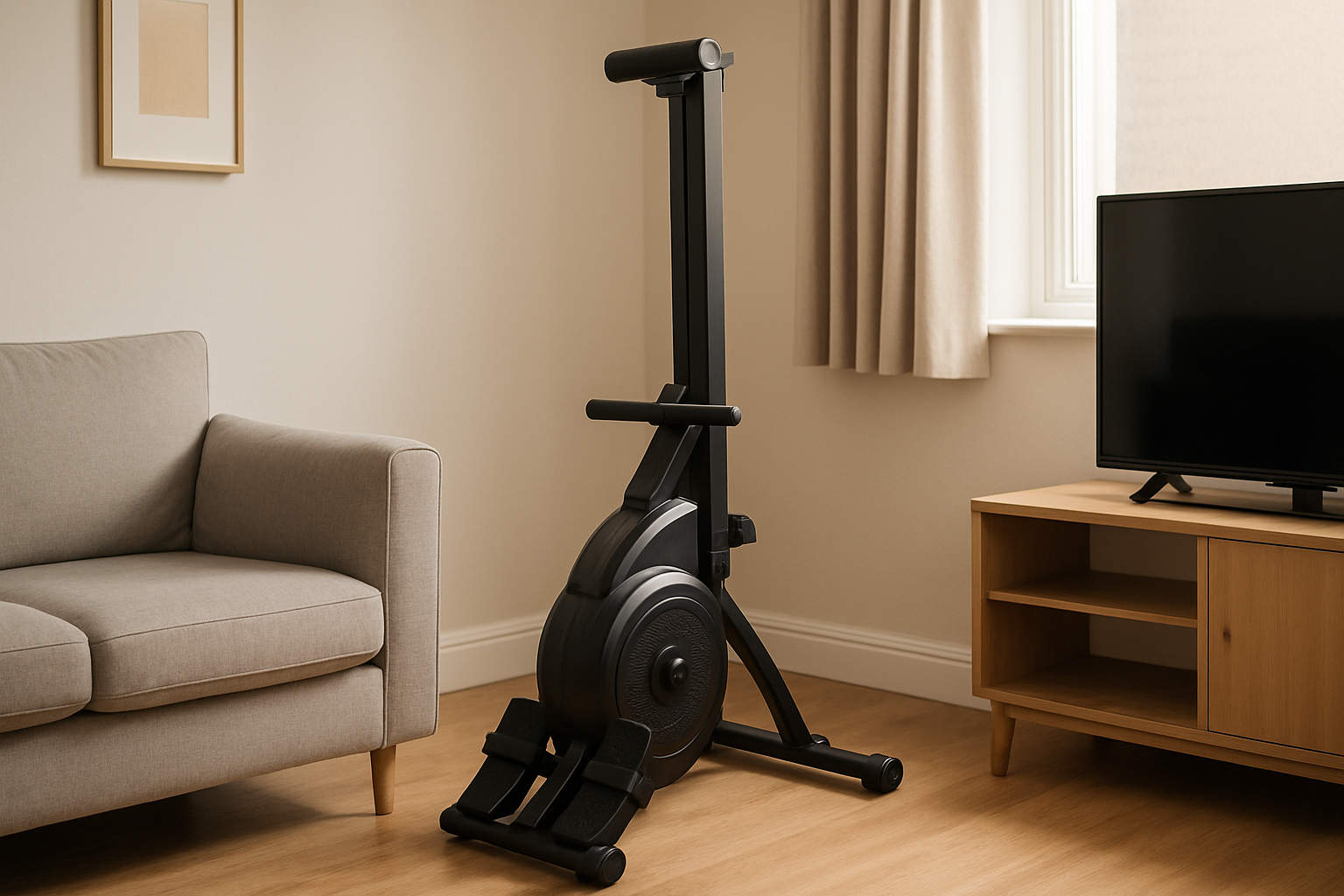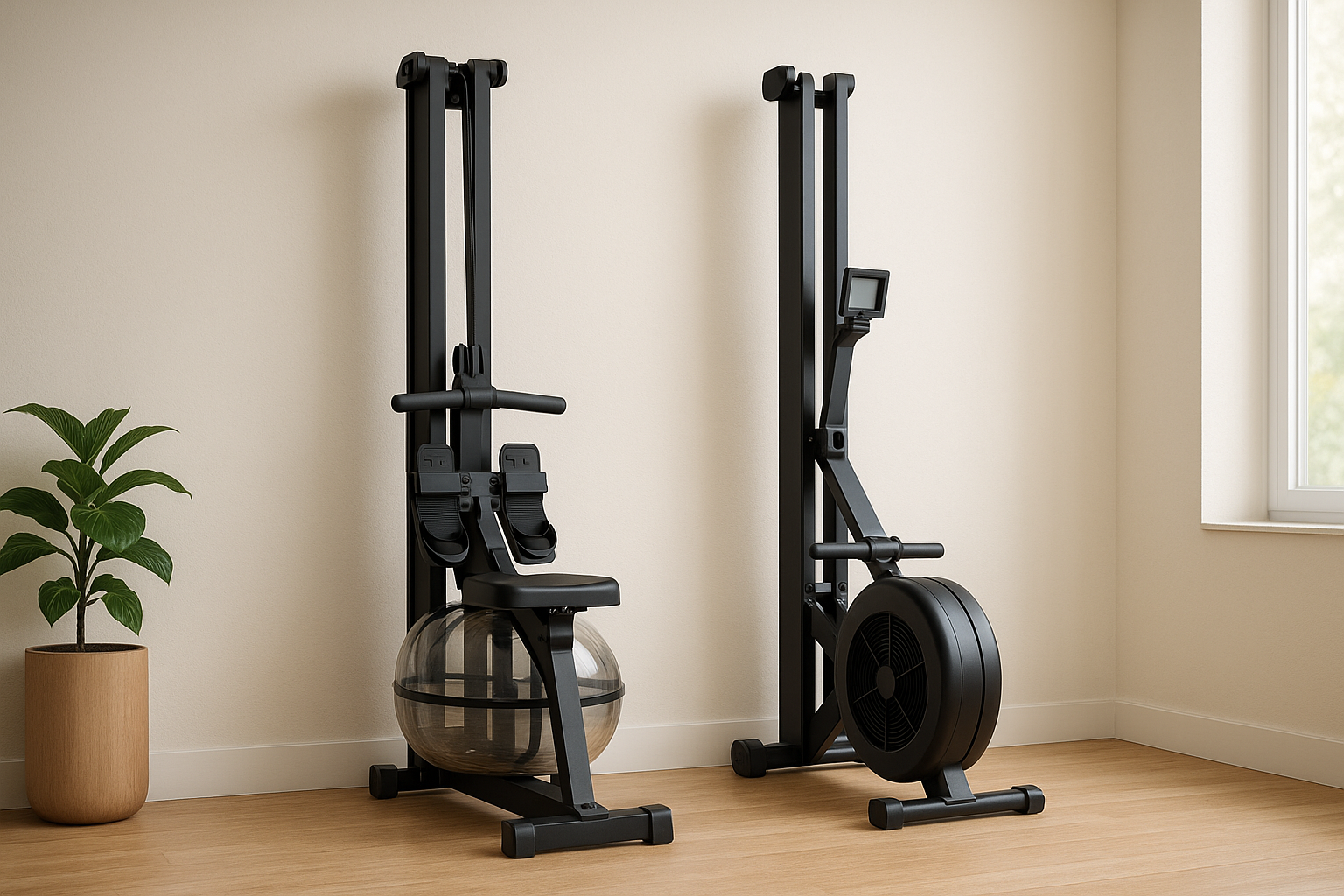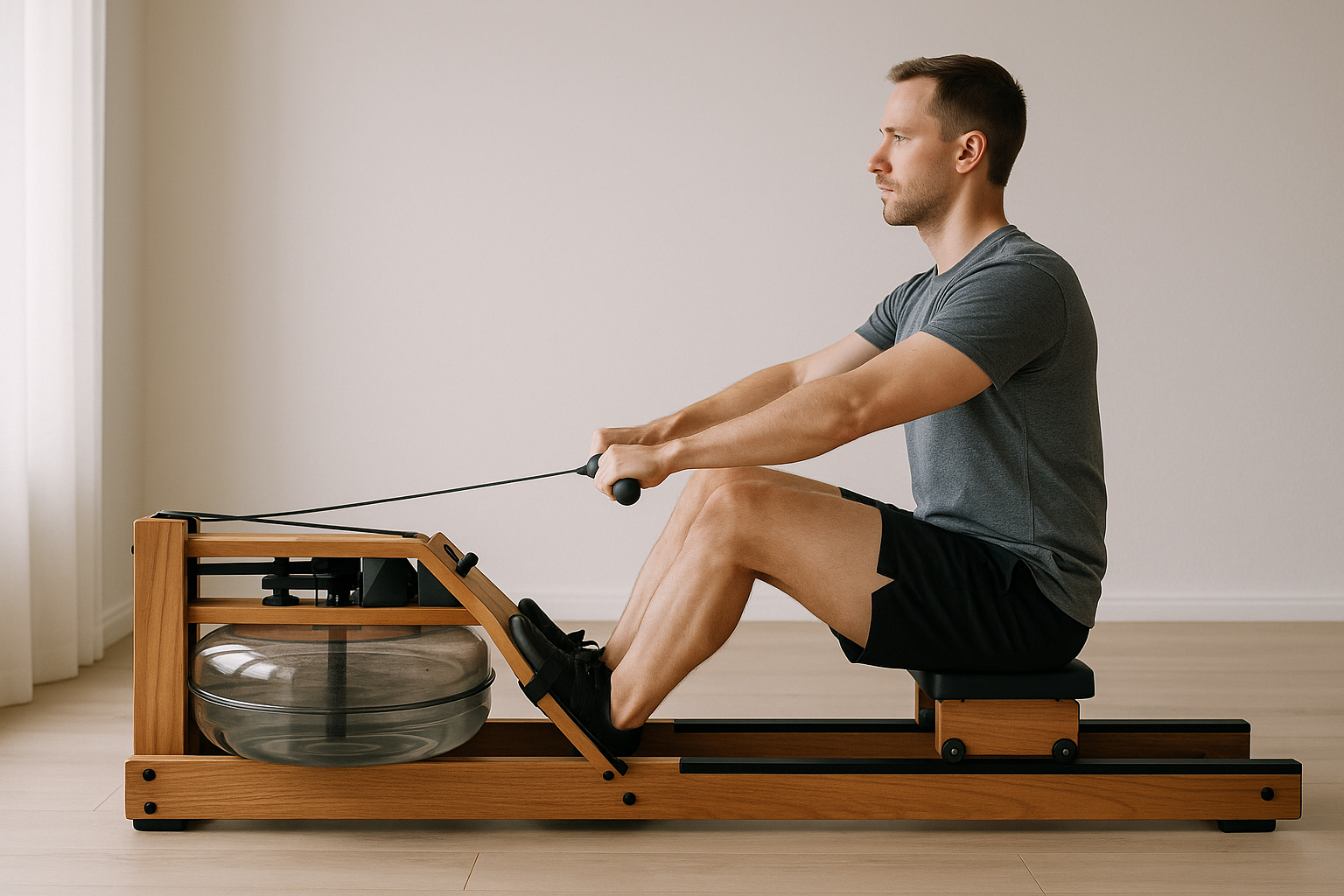Best Compact Rowing Machines UK (2025 Guide)
Best Compact Rowing Machines UK (2025 Guide)
Find a quiet, foldable rower that fits your flat — without emptying your wallet.
By Alex Ward | Reviewed by Dr. Sophie Bennett, PhD Sport Science | Last updated September 2025
Estimated reading time: 12 minutes

TL;DR
- Pick a magnetic rower for the quietest ride in flats; air rowers feel great but are louder.
- “Compact” generally means a folded footprint under ~120 × 55 cm and total length under ~200 cm.
- Top value: JLL R200 (budget, very quiet) and Bluefin Blade 2.0 (app support, compact upright fold).
- Measure your space twice — include handle travel and foot clearance — before you buy.
- Aim for 3–4 sessions/week; see our 8‑week plan and low‑noise tips below.
Table of contents
- Who this guide is for
- What counts as a compact rowing machine?
- How to choose: space, noise, resistance, comfort, value
- Best compact rowing machines UK: our picks
- Quick comparison table
- How to measure and set up in a small space
- 8‑week compact-rower programme (with quiet options)
- Space and budget tips
- Recommended reading and internal links
- FAQs
- Conclusion and next steps
- Image and media plan
- Disclaimer, safety and accessibility
- Analytics and conversion cues
- References
Small-space rowing, solved
If you train at home in a UK flat or a mixed-use room, you need a rower that folds away, runs quietly, and doesn’t wobble. This guide cuts through the noise with realistic footprints, noise notes for neighbours, and honest value picks under £300–£1,000. You’ll learn how to measure properly, what resistance type suits your space, and how to get fitter in 8 weeks.
What counts as a compact rowing machine?
Definition (snippet-friendly): A compact rowing machine is a home rower with a total length under ~200 cm and a folded footprint around or below 120 × 55 cm, designed to store upright or in half-fold to save floor space.
Compact doesn’t mean flimsy. The best small-space rowers still offer a smooth stroke, adequate resistance, and a stable frame for users up to 100–120 kg.
How to choose: space, noise, resistance, comfort, value
1) Space and storage
- Footprint in use: Measure the full length (usually 160–200 cm) and width (45–55 cm). Add 50 cm clearance behind the rail for safe mounting.
- Folded size: Upright-fold models park on the front end, reducing floor space to roughly 55 × 55–70 cm; half-folders reduce length to ~90–120 cm.
- Ceiling height: Upright storage needs about rower length plus 10–15 cm. For most, 220–235 cm ceilings are fine.
2) Noise level (for flats)
- Magnetic: Quietest; ideal for early/late sessions in flats.
- Air: Best “on-water” feel but louder due to the fan. Use a mat.
- Hybrid/water: Smoother feel; noise is a soft whoosh but more mass and maintenance.
3) Resistance and feel
- Magnetic: Fixed levels (e.g., 8–24). Great for steady cardio and intervals; consistent and predictable.
- Air: Resistance scales with effort. Great for sprints; slightly bulkier and louder.
4) Comfort and fit
- Rail length: Tall users (≥190 cm) need a longer rail; check inseam capacity if listed.
- Seat height: 35–45 cm is easier on knees/hips when standing up.
- Handle path & footplates: Oversized, angle-adjustable footplates reduce ankle niggles; a contoured handle protects wrists.
5) Connectivity and console
- Basic consoles: Time, strokes, distance, calories.
- App support: Look for Bluetooth to Kinomap/other apps if you want guided sessions and progression.
6) Budget and value
- Under £300: Entry-level magnetic; compact and quiet, lighter frames.
- £300–£600: Better build, smoother drive, some app support.
- £600–£1,000: Premium feel, higher capacities, advanced consoles; still some compact picks.
Best compact rowing machines UK: our picks
Prices fluctuate — the ranges below are guides. Always use a protective mat on hard floors to reduce noise and protect neighbours.
1) JLL R200 Home Rowing Machine (Magnetic, Folding)
Verdict: A superb value, ultra-quiet starter rower that folds small and suits most UK flats.
- Resistance/drive: Manual magnetic, 10 levels
- Dimensions in use: ~180 × 52 cm; height ~75 cm
- Folded footprint (upright): ~120 × 52 cm; height ~120 cm
- Max user weight: 100 kg
- Console: Time, strokes, distance, calories
- App support: None (basic console)
Pros: Very quiet; compact fold; budget-friendly; simple to maintain.
Cons: Lighter frame; taller users may max the rail; basic metrics.
Best for: Beginners, quiet flats, under £300.
Typical UK price: £229–£299.
2) Bluefin Fitness Blade 2.0 (Magnetic, Upright Fold, App)
Verdict: Compact and quiet with Bluetooth for Kinomap — top pick if you want guided workouts in a small space.
- Resistance/drive: Magnetic, 8–16 levels (model dependent)
- Dimensions in use: ~180 × 75 cm
- Folded footprint (upright): ~55 × 55 cm; height ~120–130 cm
- Max user weight: 120 kg
- Console: LCD + Bluetooth
- App support: Kinomap-compatible
Pros: Upright storage is genuinely compact; quiet; app adds motivation.
Cons: Wider footprint in use; seat may feel firm on first rides.
Best for: Small homes wanting coaching features, under £500.
Typical UK price: £349–£449.
3) Bodymax R40 Rowing Machine (Magnetic, Folding)
Verdict: Solid middle-ground build with a smooth stroke and compact fold; good for mixed households.
- Resistance/drive: Magnetic, 8–12 levels
- Dimensions in use: ~185 × 52 cm
- Folded footprint: ~100–110 × 52 cm
- Max user weight: 120 kg
- Console: Time, strokes, distance, calories, scan
- App support: None
Pros: Stable frame; comfortable seat; easy fold and wheel-away.
Cons: No Bluetooth; resistance tops out before heavy intervals for strong rowers.
Best for: Families and renters; under £400.
Typical UK price: £299–£399.
4) Sunny Health & Fitness SF‑RW5515 (Magnetic, Folding)
Verdict: A proven budget option with a long rail for taller users, yet still foldable.
- Resistance/drive: Magnetic, 8 levels
- Dimensions in use: ~203 × 51 cm
- Folded footprint: ~105 × 51 cm
- Max user weight: 113 kg
- Console: Basic LCD
- App support: None
Pros: Longer rail fits taller bodies; quiet; often discounted.
Cons: Longer in use than others; basic console; availability can vary in the UK.
Best for: Taller users on a budget.
Typical UK price: £249–£329.
5) Bodymax Oxbridge HR Air Rowing Machine (Air, Upright Storage)
Verdict: If you want the punchy, scalable feel of air but still need upright storage, this is the pragmatic compromise.
- Resistance/drive: Air fan
- Dimensions in use: ~220 × 60 cm
- Folded/upright storage: Stores upright on end
- Max user weight: 120 kg
- Console: Time, distance, strokes, calories; heart rate receiver
- App support: None
Pros: Classic air feel for intervals; robust; HR support.
Cons: Louder than magnetic; longer in use; not ideal for very noise‑sensitive flats.
Best for: Budget air-rower seekers who can train at reasonable hours.
Typical UK price: £499–£599.
Quick comparison table
| Model | Resistance | Folded footprint | Max user | Noise | App | Typical UK price |
|---|---|---|---|---|---|---|
| JLL R200 | Magnetic (10) | ~120 × 52 cm | 100 kg | Very quiet | No | £229–£299 |
| Bluefin Blade 2.0 | Magnetic (8–16) | ~55 × 55 cm (upright) | 120 kg | Very quiet | Yes (Kinomap) | £349–£449 |
| Bodymax R40 | Magnetic (8–12) | ~100–110 × 52 cm | 120 kg | Quiet | No | £299–£399 |
| Sunny SF‑RW5515 | Magnetic (8) | ~105 × 51 cm | 113 kg | Quiet | No | £249–£329 |
| Bodymax Oxbridge HR | Air | Upright store | 120 kg | Louder | No | £499–£599 |

How to measure and set up in a small space
- Measure length and width: Tape out the in-use footprint. Add 50 cm behind the rail and 30 cm either side for safe mounting.
- Check ceiling height: For upright storage, ensure rower length + 10–15 cm clearance.
- Protect the floor: Place a 6–8 mm rubber mat to reduce vibration and noise.
- Plan cable and Wi‑Fi: If you’ll use apps, ensure Bluetooth pairing space and router reach.
- Test seat height: If hip/knee mobility is limited, opt for a seat ≥40 cm high.
Common mistakes (and fixes)
- Buying on folded size only: Confirm in‑use length so the handle won’t hit furniture.
- Ignoring floor noise: Use a mat and row on lower magnetic settings in flats.
- Seat discomfort: Add a thin gel pad or adjust footplate angle to improve hip position.
8‑week compact-rower programme (quiet-friendly)
Rowing hits large muscle groups for efficient cardio. UK Chief Medical Officers recommend at least 150 minutes of moderate activity weekly. Here’s a progressive, flat-friendly plan using Rate of Perceived Exertion (RPE 1–10).
Weekly schedule (3–4 days/week)
- Week 1–2: 3 sessions. 20–25 min each. Mostly RPE 4–5.
- Week 3–4: 3–4 sessions. 25–30 min. Introduce short intervals.
- Week 5–6: 4 sessions. 30–35 min. Longer intervals.
- Week 7–8: 4 sessions. 35–40 min. Threshold intervals.
Warm‑up (5 minutes)
- 2 min easy row (RPE 3–4)
- 1 min legs‑only strokes (no arm pull)
- 1 min arms/body‑only (light pull)
- 1 min easy full strokes
Sample sessions
Beginner steady (quiet): 20 min continuous at RPE 4–5 on a magnetic setting 3–5. Breathe through your nose if noise is a concern.
Intervals (Week 3–4): 6 × 2 min at RPE 6 with 1 min easy between. Keep stroke rate 22–26 spm to stay quiet.
Threshold set (Week 7–8): 3 × 8 min at RPE 7 with 3 min recovery. Dial resistance so the fan/magnet noise stays neighbour‑friendly.
Cool‑down and mobility (5 minutes)
- 3 min light row (RPE 3)
- Hamstring, hip flexor and thoracic rotations (20–30 sec each side)
Technique cues (for safety)
- Drive: Legs first, then body, then arms.
- Recovery: Arms, body, legs (reverse of drive).
- Neutral spine; soft knees at catch; handle path just below ribs.

Space and budget tips
- Go magnetic for flats: It’s the quietest option and usually the most compact.
- Mat matters: A 6–8 mm rubber mat can make a bigger difference than you think for downstairs neighbours.
- Choose upright storage: If floor space is tight, upright‑fold models park neatly beside a bookcase.
- Buy once: Spending £300–£500 often gets you a smoother drive and better stability — worth it if you row 3–4×/week.
Recommended reading and internal links
Build your cardio toolkit and learn technique with these resources:
- [Internal link: Rowing machines category — compare models → https://www.simplyfitnessequipment.co.uk/fitness-equipment/rowing-machines/]
- [Internal link: Bodymax Oxbridge HR Air Rowing Machine review → https://www.simplyfitnessequipment.co.uk/reviews/rowing-machines/bodymax-oxbridge-hr-air-rowing-machine/]
- [Internal link: JLL 2‑in‑1 Elliptical Cross Trainer & Exercise Bike CT100 review → https://www.simplyfitnessequipment.co.uk/reviews/jll-2-in-1-elliptical-cross-trainer-exercise-bike-ct100-review/]
- [Internal link: How to train for a 5k using a treadmill → https://www.simplyfitnessequipment.co.uk/blog/how-to-train-for-a-5k-using-a-treadmill/]
- [Internal link: Building the perfect home gym (UK) → https://www.simplyfitnessequipment.co.uk/blog/building-perfect-home-gym/]
FAQs
What is the quietest type of compact rowing machine for flats?
Magnetic rowers are the quietest because resistance is created without airflow. Pair yours with a rubber mat and lower stroke rate (22–26 spm) to minimise vibration. Air rowers feel great but the fan is louder, so they’re better for detached homes or daytime training.
How much space do I need for a compact rower?
Plan for roughly 180–200 cm length and 50–55 cm width in use. For upright storage, allow around 55 × 55–70 cm of floor space and enough ceiling height for the rower length plus 10–15 cm clearance.
Are folding rowers stable enough for hard intervals?
Yes, if the frame is well built and on a flat surface. Mid‑range models (around £300–£600) balance compact storage with sturdier rails and better weight limits. Use a mat and check all locking pins before each session.
Magnetic vs air: which is better for small spaces?
Magnetic is better for small, shared spaces due to low noise and simpler storage. Air offers more realistic resistance scaling but is louder and typically longer. If neighbours are a concern, choose magnetic.
What maintenance does a compact rower need?
Wipe the rail after sessions, check bolts monthly, and vacuum dust from vents (for air rowers). For magnetic models, inspect the belt/strap for wear every 3–6 months. Keep it on a mat to protect the floor and reduce vibration.
Will a compact rower fit tall users?
Some compact models have shorter rails. If you’re over 190 cm tall, look for longer rails (or listed inseam capacity) and test the catch position. The Sunny SF‑RW5515 is longer in use and suits taller bodies.
Can I get a good rower under £300?
Yes. The JLL R200 and similar budget magnetic models offer quiet, effective cardio for beginners. Expect basic consoles and lighter frames. If you’ll row 3–4× weekly long term, consider stretching to £300–£500 for smoother drive and durability.
How do I row with good form to avoid back pain?
Drive with legs first, then lean slightly from hips, then pull with arms; reverse on recovery. Keep a neutral spine, relaxed shoulders, and avoid over‑reaching at the catch. Start with lower resistance and build gradually.
Conclusion and next steps
For UK flats and small homes, a magnetic, upright‑fold rower is your best bet. If you want app coaching, pick the Bluefin Blade 2.0; for the lowest cost and noise, the JLL R200 is hard to beat; for a sturdier mid‑range, the Bodymax R40 delivers. Measure your space, lay a mat, and follow our 8‑week plan for results you can feel.
Image and media plan
- Hero: Compact rower folded beside a sofa in a UK flat (alt: Compact magnetic rowing machine folded upright in a small UK flat living room).
- Comparison: Two folded rowers side‑by‑side (alt: Side-by-side image of folded rowing machines showing compact footprints).
- Form cue: Legs‑body‑arms sequence graphic (alt: Rowing technique cues showing legs-body-arms sequence for safe home rowing).
- Setup: Measuring floor space with tape and mat (alt: Person measuring floor space and placing rubber mat for a compact rower in a UK home).

Optional video (60–90s): 1) How to measure and store upright, 2) Quiet setup tips, 3) 60‑second technique basics.
Compliance, safety and accessibility
Medical disclaimer: This article provides general fitness information and is not a substitute for medical advice. Consult your GP before starting a new programme, especially if you have existing conditions or are pregnant.
Safety: Use a non‑slip mat, check pins/bolts monthly, and stop if you feel pain. Keep children and pets away during sessions.
Accessibility: Choose a higher seat height (≥40 cm) if standing from low positions is difficult. Consider straps with larger buckles for dexterity needs.
Analytics and conversion cues
- Primary CTAs (positions): After intro (above-the-fold), after Top Picks, and in Conclusion.
- Button copy ideas: “Check price”, “See compact rowers in stock”, “Compare sizes”, “Get weekly workout plans & deals”.
- Track events: CTA clicks (by position), table outbound clicks, TOC jumps, product card link clicks, newsletter sign‑ups.
References
- NHS Live Well — Physical activity guidelines for adults. Accessed 2025.
- UK Chief Medical Officers’ Physical Activity Guidelines (2019). Department of Health and Social Care.
- Chartered Society of Physiotherapy — Warm up and cool down advice for exercise. Accessed 2025.